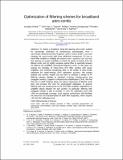| dc.contributor.author | Chang, Guoqing | |
| dc.contributor.author | Li, Chih-Hao | |
| dc.contributor.author | Phillips, David F. | |
| dc.contributor.author | Szentgyorgyi, Andrew | |
| dc.contributor.author | Walsworth, Ronald L. | |
| dc.contributor.author | Kaertner, Franz X. | |
| dc.date.accessioned | 2014-05-16T18:12:57Z | |
| dc.date.available | 2014-05-16T18:12:57Z | |
| dc.date.issued | 2012-10 | |
| dc.date.submitted | 2012-10 | |
| dc.identifier.issn | 1094-4087 | |
| dc.identifier.uri | http://hdl.handle.net/1721.1/87040 | |
| dc.description.abstract | To realize a broadband, large-line-spacing astro-comb, suitable for wavelength calibration of astrophysical spectrographs, from a narrowband, femtosecond laser frequency comb (“source-comb”), one must integrate the source-comb with three additional components: (1) one or more filter cavities to multiply the source-comb’s repetition rate and thus line spacing; (2) power amplifiers to boost the power of pulses from the filtered comb; and (3) highly nonlinear optical fiber to spectrally broaden the filtered and amplified narrowband frequency comb. In this paper we analyze the interplay of Fabry-Perot (FP) filter cavities with power amplifiers and nonlinear broadening fiber in the design of astro-combs optimized for radial-velocity (RV) calibration accuracy. We present analytic and numeric models and use them to evaluate a variety of FP filtering schemes (labeled as identical, co-prime, fraction-prime, and conjugate cavities), coupled to chirped-pulse amplification (CPA). We find that even a small nonlinear phase can reduce suppression of filtered comb lines, and increase RV error for spectrograph calibration. In general, filtering with two cavities prior to the CPA fiber amplifier outperforms an amplifier placed between the two cavities. In particular, filtering with conjugate cavities is able to provide <1 cm/s RV calibration error with >300 nm wavelength coverage. Such superior performance will facilitate the search for and characterization of Earth-like exoplanets, which requires <10 cm/s RV calibration error. | en_US |
| dc.description.sponsorship | United States. National Aeronautics and Space Administration (Grant NNX10AE68G) | en_US |
| dc.description.sponsorship | United States. National Aeronautics and Space Administration (Grant NNX09AC92G) | en_US |
| dc.description.sponsorship | National Science Foundation (U.S.) (Grant AST-0905592) | en_US |
| dc.description.sponsorship | National Science Foundation (U.S.) (Grant AST-1006507) | en_US |
| dc.language.iso | en_US | |
| dc.publisher | Optical Society of America | en_US |
| dc.relation.isversionof | http://dx.doi.org/10.1364/OE.20.024987 | en_US |
| dc.rights | Article is made available in accordance with the publisher's policy and may be subject to US copyright law. Please refer to the publisher's site for terms of use. | en_US |
| dc.source | Other univ. web domain | en_US |
| dc.title | Optimization of filtering schemes for broadband astro-combs | en_US |
| dc.type | Article | en_US |
| dc.identifier.citation | Chang, Guoqing, Chih-Hao Li, David F. Phillips, Andrew Szentgyorgyi, Ronald L. Walsworth, and Franz X. Kaertner. “Optimization of Filtering Schemes for Broadband Astro-Combs.” Optics Express 20, no. 22 (October 22, 2012): 24987. © 2012 OSA | en_US |
| dc.contributor.department | Massachusetts Institute of Technology. Department of Electrical Engineering and Computer Science | en_US |
| dc.contributor.department | Massachusetts Institute of Technology. Research Laboratory of Electronics | en_US |
| dc.contributor.mitauthor | Chang, Guoqing | en_US |
| dc.contributor.mitauthor | Kaertner, Franz X. | en_US |
| dc.relation.journal | Optics Express | en_US |
| dc.eprint.version | Final published version | en_US |
| dc.type.uri | http://purl.org/eprint/type/JournalArticle | en_US |
| eprint.status | http://purl.org/eprint/status/PeerReviewed | en_US |
| dspace.orderedauthors | Chang, Guoqing; Li, Chih-Hao; Phillips, David F.; Szentgyorgyi, Andrew; Walsworth, Ronald L.; Kaertner, Franz X. | en_US |
| dc.identifier.orcid | https://orcid.org/0000-0002-8733-2555 | |
| mit.license | PUBLISHER_POLICY | en_US |
| mit.metadata.status | Complete | |
